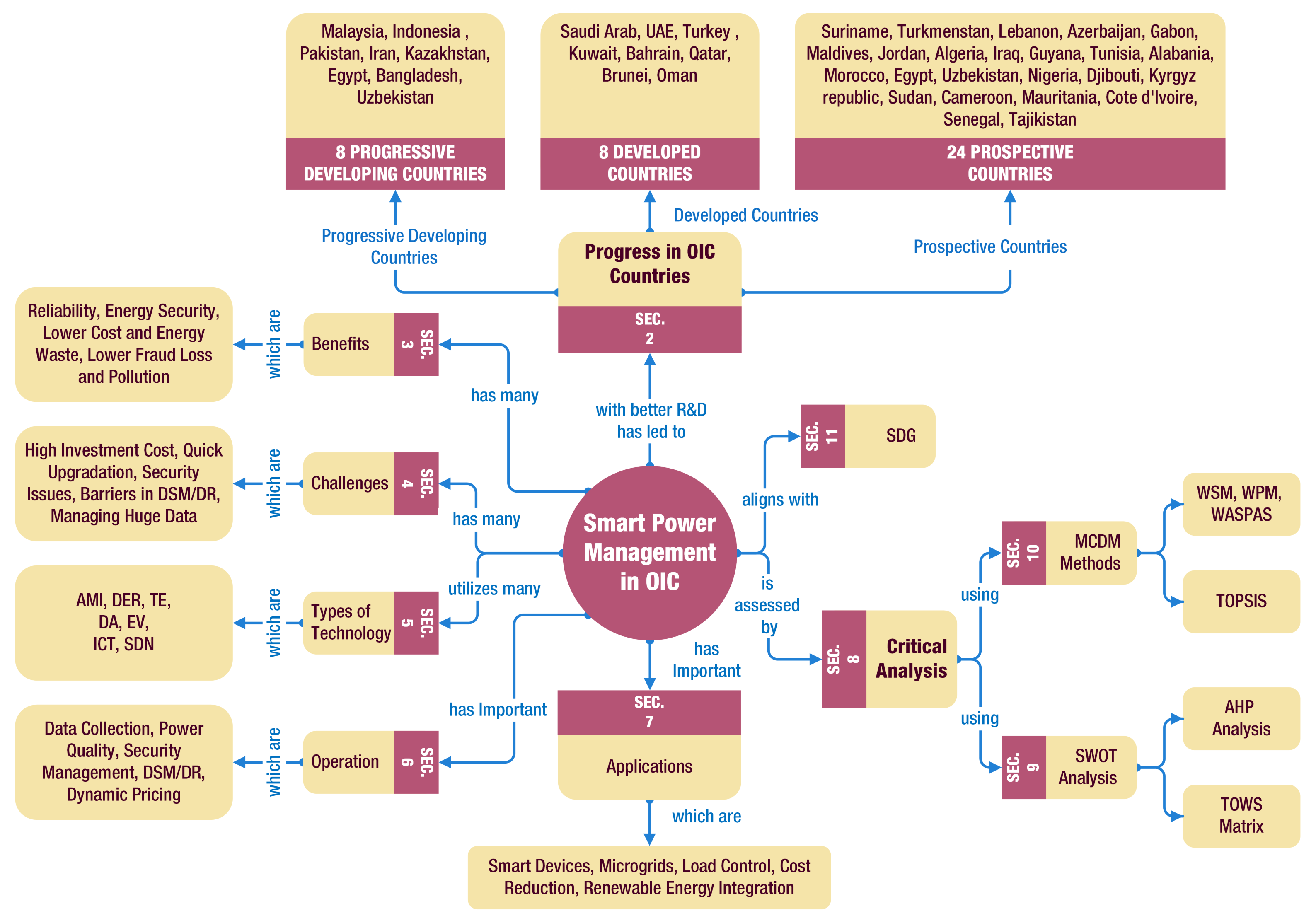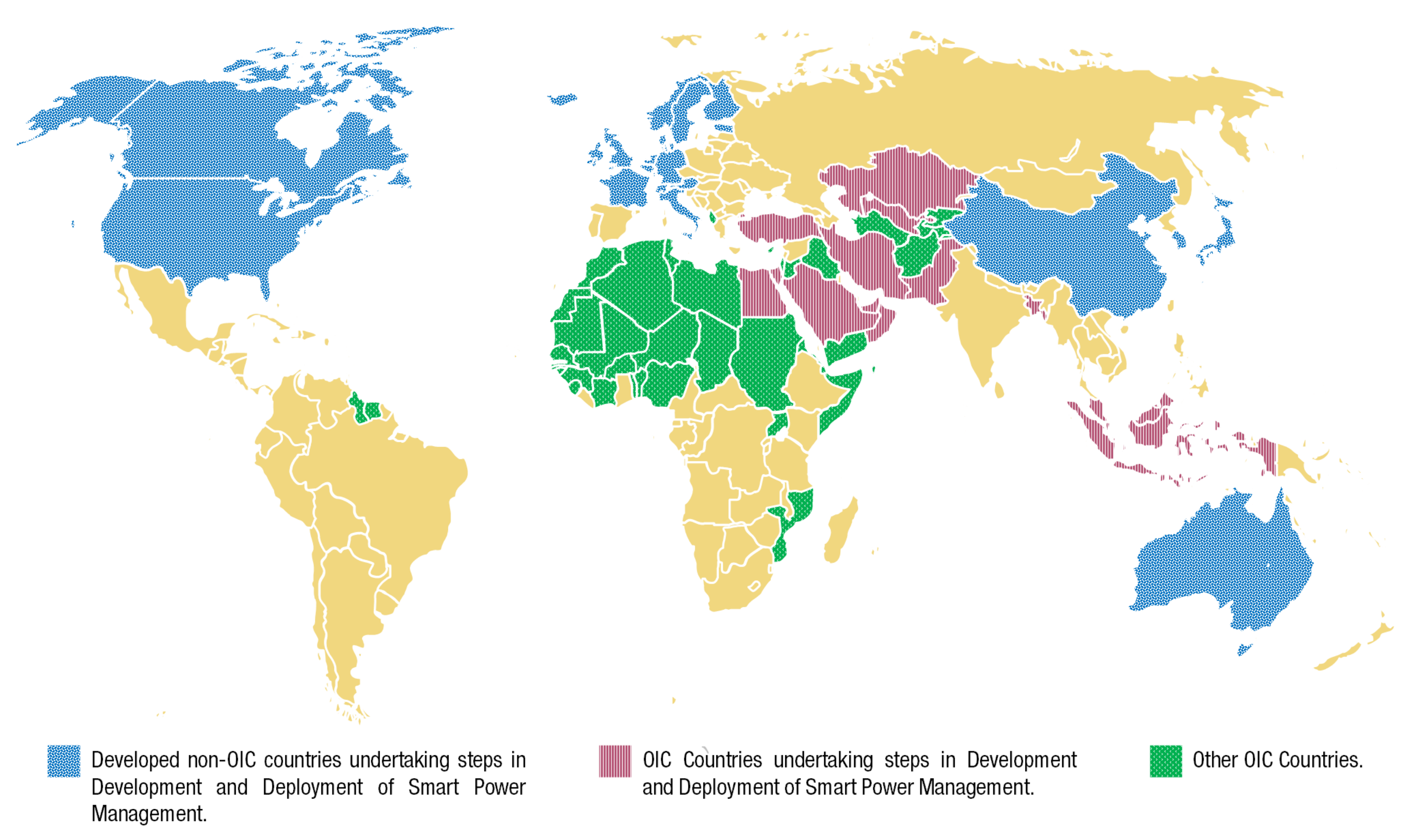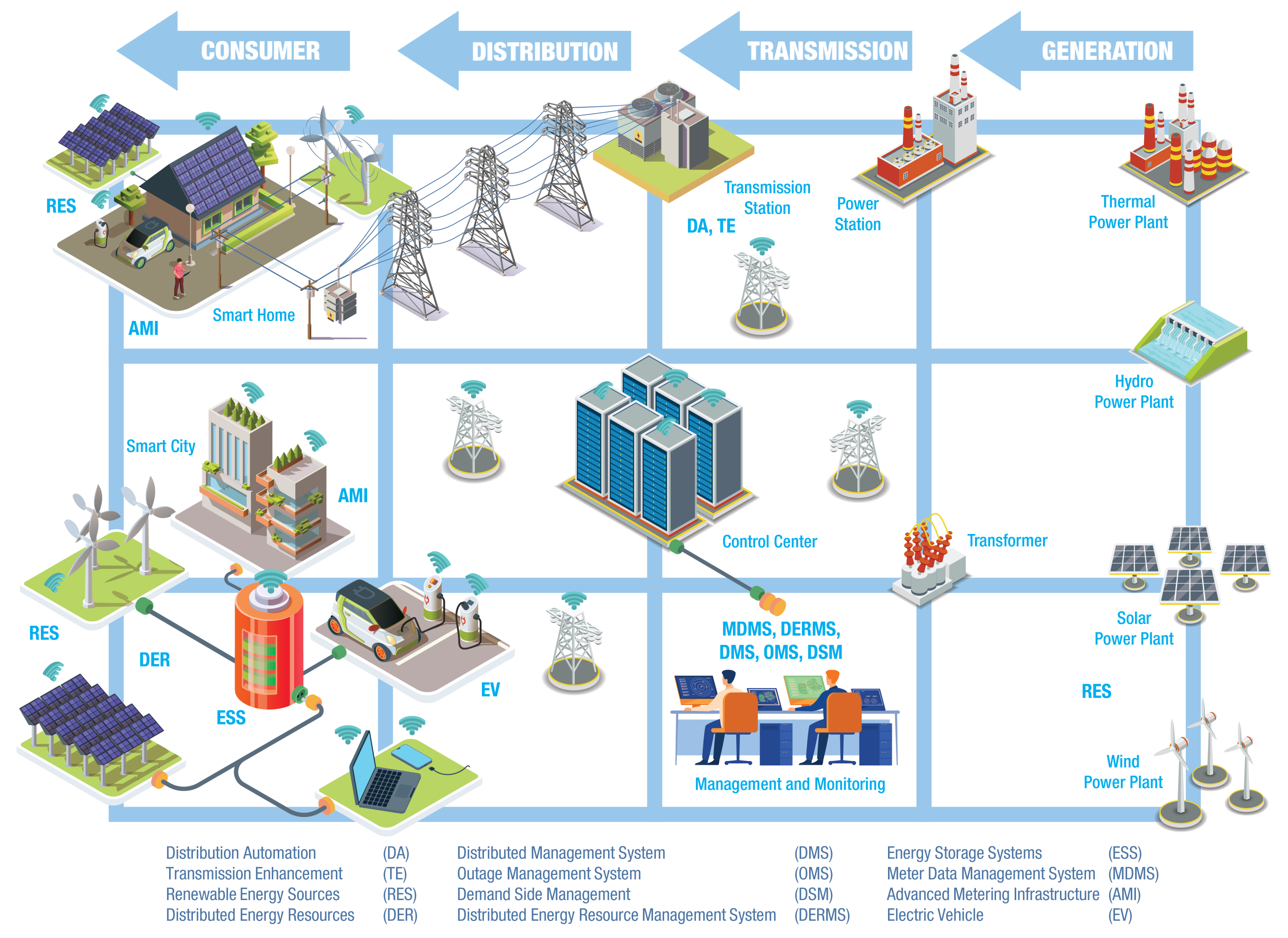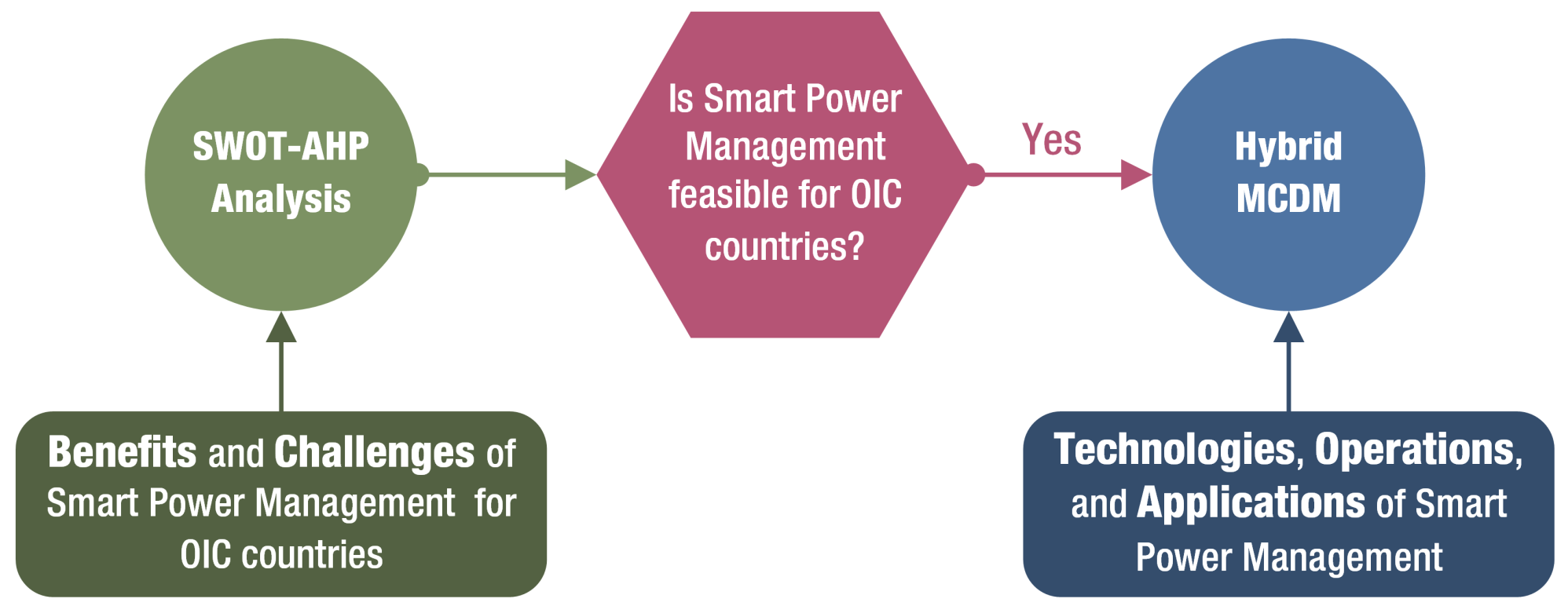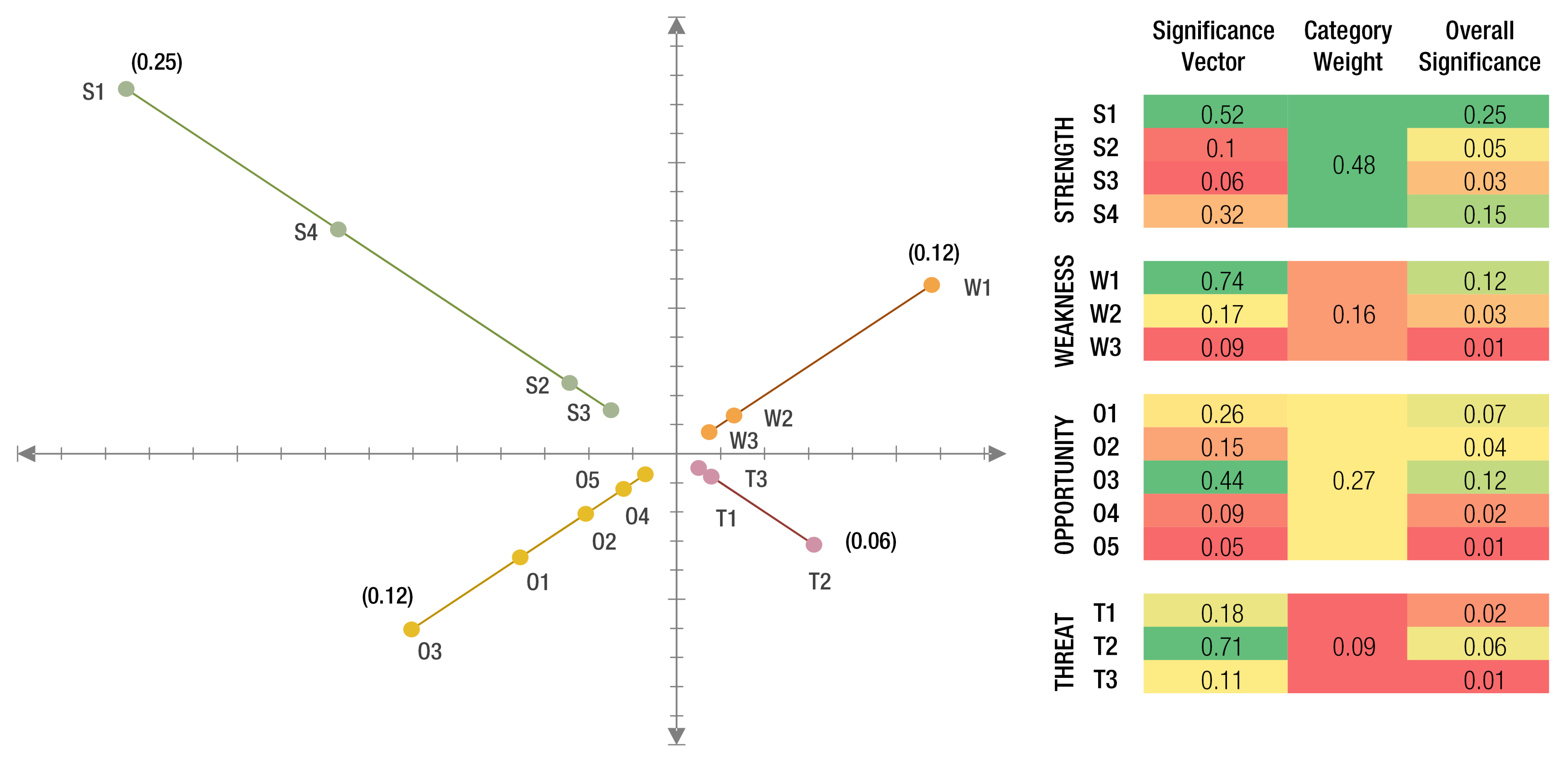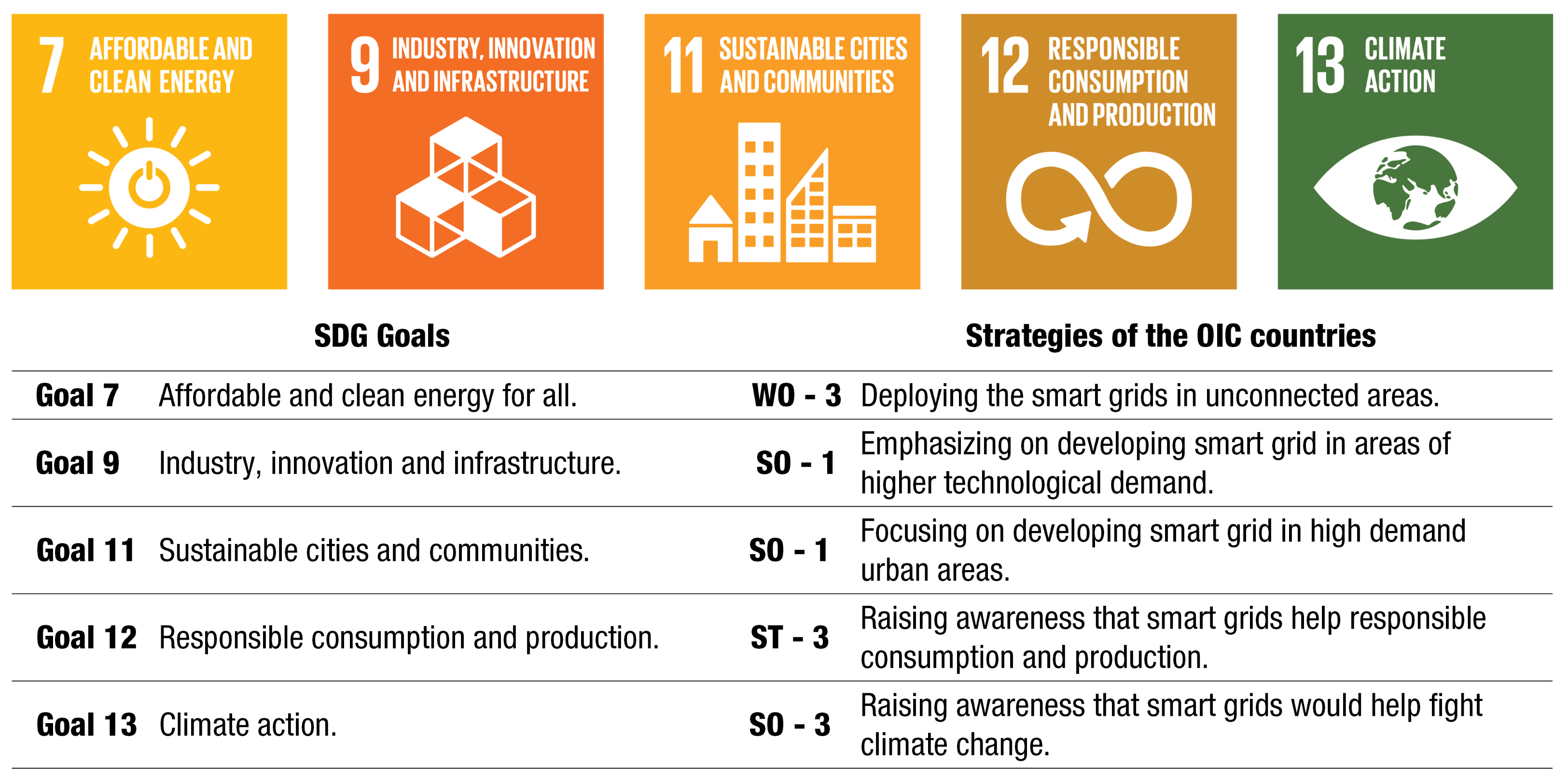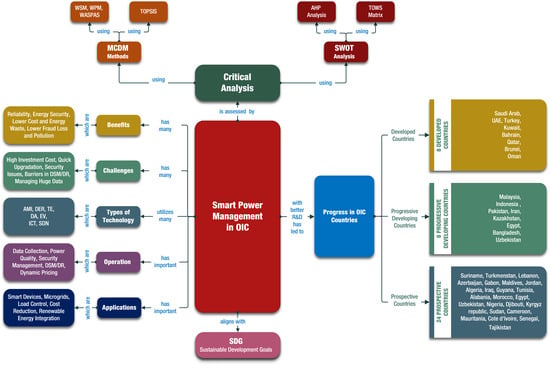Figure 1.
Structure of this paper using the concept mapping approach.
Figure 1.
Structure of this paper using the concept mapping approach.
Figure 2.
OIC countries and non-OIC developed countries on the world map that are undertaking steps in the development and deployment of smart power management.
Figure 2.
OIC countries and non-OIC developed countries on the world map that are undertaking steps in the development and deployment of smart power management.
Figure 3.
The overall architecture of the smart power management technologies.
Figure 3.
The overall architecture of the smart power management technologies.
Figure 4.
The overall process of the critical analysis.
Figure 4.
The overall process of the critical analysis.
Figure 5.
Process of the SWOT-AHP-TOWS analysis.
Figure 5.
Process of the SWOT-AHP-TOWS analysis.
Figure 6.
Process of hybrid MCDM analysis.
Figure 6.
Process of hybrid MCDM analysis.
Figure 7.
The perception map of the SWOT Factors.
Figure 7.
The perception map of the SWOT Factors.
Figure 8.
Smart Power management adaptation strategies in the OIC countries and the Sustainable Development Goals (SDGs).
Figure 8.
Smart Power management adaptation strategies in the OIC countries and the Sustainable Development Goals (SDGs).
Table 1.
Summary of advancements of the non-OIC member countries with smart power management initiatives.
Table 1.
Summary of advancements of the non-OIC member countries with smart power management initiatives.
| Countries | Advancement with Smart Power Management Initiatives |
|---|
| USA | 39 states and the district of Columbia took 276 policies and deployment actions. Investments are expected to rise to 13.8 billion US dollars in 2024 [5]. |
| Canada | 135 smart grid Research and Development (R&D) projects worth 785 million Canadian dollars are being undertaken. All of Canada’s 10 provinces started smart grid applications [5]. |
| UK | UK’s Department of Energy and Climate Change invested 278 renewable energy projects worth 175 million pounds, as well as 70 million pounds in the R&D of smart energy management [5]. |
| France | R&D projects related to smart power management received more than 120 million euros of public and private investments. Twenty-eight major demonstrators were funded so far [5]. |
| Australia | The Australian Renewable Energy Agency (ARENA) invested in smart power management R&D, which ranges from 7 million to 35.7 million Australian dollars on advanced power system services, demand response, renewable energy projects, and short-term forecasting [5]. |
| Denmark | Approximately 134 million euros would be invested in smart power management R&D by 2024 [5]. |
| Germany | Over 200 million euros are being invested on 5 major smart power management and smart grid projects [5]. |
| Republic of Korea | The domestic smart grid market grew to 2.2 billion US dollars in 2020, at a growth rate of 28 percent from 2012. In 2018, a smart energy city was planned to be built in Seoul [5]. |
| Japan | It is set to build the largest Energy Storage System (ESS) of 720 MWh storage. Significant efforts are being undertaken to develop Virtual Power Plants (VPPs) and Electric Vehicle (EV) infrastructure [6]. |
| China | China’s National Key Research and Development Program was formed in 2011 to spearhead the transition to smart power management in the whole country by 2050 [5]. |
| India | The government is planning to build 100 smart cities, investing in renewable energy and EVs [5]. |
Table 2.
Summary of advancements of the OIC member countries with smart power management initiatives.
Table 2.
Summary of advancements of the OIC member countries with smart power management initiatives.
| Countries | Advancement with Smart Power Management Initiatives |
|---|
| Developed countries (8 countries) |
| KSA | In KSA, the Electricity and Co-Generation Regulatory Authority (ECRA) and the Saudi Electricity Company (SEC) both have strategies relating to smart grid implementation [5]. |
| UAE | In UAE, over a million smart meter installations have been completed since 2016 [9]. |
| Turkey | Turkey is the biggest renewable energy user of the OIC [10]; It has set a roadmap to implement a smart grid by 2035 [11] |
| Kuwait | Kuwait has deployed over 1 million smart meters [12]; partnering up with EU and private corporations in deploying Advanced Metering Infrastructure (AMI) and Information and Communications Technology (ICT) [13,14], and is also planning to incorporate renewable energy [15]. |
| Bahrain | In Bahrain, 20% households already have smart meters [16]; Bahrain Sustainable Energy Unit (SEU) has been tasked with the formulation of strategies and policies, and cooperating with private corporations [17]. |
| Qatar | Qatar is planning a nationwide smart grid roll-out [18]. DSM and EV charging programs have been initiated [19]. |
| Brunei | Brunei is deploying 200 thousand smart meters to bring smart power management schemes to every household [20]. |
| Oman | In Oman, smart meters are being installed at several key parts of the country [21]. |
| Progressive developing countries (8 countries) |
| Malaysia | In Malaysia, Government plans to install almost 9.1 million smart meters in peninsular Malaysia by 2026 [22]. |
| Indonesia | Indonesia is slated to have 25 operational smart grid projects by 2024 [23]. |
| Pakistan | In Pakistan, funds have been secured for Advanced Metering Infrastructure (AMI), Distribution Automation (DA) and Distributed Energy Resources (DER) development; installed over 40 thousand smart meters in 3 cities and undertaking limited scale projects [24]. |
| Iran | Iran is focusing on Advanced Metering Infrastructure (AMI) development [25] and plans to fully incorporate smart power management by 2025 [25], and the share of renewable energy is increasing [26]. |
| Kazakhstan | Kazakhstan launched a pilot project in 2017 [27], and is developing its renewable energy sector and incorporating Energy Storage Systems (ESS) [28]. |
| Egypt | Egypt has signed a contract with Schneider Electric to implement the first country-wide smart grid project in the middle east [29]. |
| Bangladesh | Massive implementation of individual solar home system in rural areas has led to it being the global leader in Solar Home System (SHS) implementation [30]. |
| Uzbekistan | Uzbekistan is investing in smart power management, and have established a control center for smart meters present in the country [31]. |
| Prospective OIC countries (24 countries) |
| Nigeria [32], Cameroon [33], Morocco [34], Algeria [35] and Jordan [36] are investing in renewable energy and are expected to adopt smart power management. Suriname, Turkmenistan, Lebanon, Azerbaijan, Gabon, Maldives, Iraq, Guyana, Tunisia, Alabania, Djibouti, Kyrgyz republic, Sudan, Mauritania, Cote d’lvoire, Senegal, and Tajikistan are the other prospective countries that are likely adopt renewable energy and smart power management in the future. |
| Under-developed OIC countries (17 countries) |
| Comoros, Benin, Chad, Guinea, Burkina Faso, Afghanistan, Uganda, Mali, Togo, The Gambia, Niger, Ivory Coast, Yemen, Somalia, Libya, West-Bank, and Sierra Leone are either underdeveloped or in a state of unrest and thus are still to go a long distance before implementing the renewable energy or smart management initiatives. |
Table 3.
Summary of the benefits of smart power management schemes in the OIC countries.
Table 3.
Summary of the benefits of smart power management schemes in the OIC countries.
| Benefits | Description |
|---|
| Lower electricity cost for consumers | Consumer cost is lowered as a result of Demand Side Management (DSM) and Demand Response (DR) and home based Distributed Energy Resources (DERs). |
| Lower expenditures for utility | High energy efficiency and efficient management can reduce utility costs [42]. |
| Increased reliability for electricity | Load shifting by Demand Side Management (DSM) and Demand Response (DR) and efficient management. |
| Increased energy security | Allows distributed generation from renewable resources. |
| Preventing energy waste | Demand Side Management (DSM) and Demand Response (DR) help remove unnecessary loads, transmission and distribution losses are also reduced due to smart grid upgrades. |
| Reduced losses through fraud detection | Smart meters, sensors and Internet of Things (IoT) prevent theft and fraud. |
| Air pollution and adverse climate change reduced | Smart power management helps integrate renewable energy to the grid more easily, reducing dependence on fossil fuels and helps reduce adverse climate change. |
Table 4.
General challenges of adopting the smart power management initiative for the OIC countries.
Table 4.
General challenges of adopting the smart power management initiative for the OIC countries.
| Challenges | Likelihood | Impact | Effects | Solutions |
|---|
| High investment cost | Moderate | High | Upgrading the entirety of the existing grids and adding new infrastructures is bound to have a hefty cost. | Plenty of strategies exist, such as inviting investors as it promises to have a high benefit to cost ratio. |
| Upgrading the grid on the go | High | Low | The existing grids have to be upgraded and also the grids have to be expanded for many OIC countries with weak grids [48,49]. | Technological leapfrogging can be implemented. |
| Technological shortcomings | High | Low | Many of the small technological devices to be used have their limitations as well as unintended problems [50]. | Workarounds have to be found for the problems or to find better replacements for them. |
| Difficulties in renewable energy integration | High | Moderate | Two-way energy flow causes management complexity and generates harmonics [48,50]. In addition, the renewable energy resources consume land area that causes land limitations for the smaller OIC member countries. | Workaround has to be found for the stability issues of two-way energy flow. In addition, proper placement of Distributed Energy Resources (DERs) has to be done accomplished by utilizing available options, such as placing photovoltaic panels in rooftops. |
| Security | Low | Moderate | Private information can be stolen by perpetrators; in addition, certain information can be hampered for the purpose of energy theft [51,52]. | Security measures have to be heightened, strong security system, and infrastructures have to be put in place. |
| Barriers in Demand Side Management (DSM) and Demand Response (DR) | Low | Moderate | Consumer and producer based barriers [50]. | Awareness has to be raised and lucrative Demand Side Management (DSM) offers have to be made to the consumers to motivate them; decisions must be made intelligibly by people with the authority to avoid any decision-making conflicts. |
| Managing huge volumes of data | High | Low | Security, identification and usage data of millions of consumers have to be managed in a very short time. | Big data and block-chain can be utilized. |
Table 5.
Summary of technologies and features used in the smart grids and smart power management schemes.
Table 5.
Summary of technologies and features used in the smart grids and smart power management schemes.
| Technologies | Description |
|---|
| A. Advanced Metering Infrastructure (AMI) |
| Smart meter | Records the consumers’ electricity consumption data in real time, as well as the power quality, and sends them to the utility. Can also be used by the utilities to regulate or supervise other devices, allowing two way communications [58,59]. |
| Meter Data Management System (MDMS) | It operates alongside Customer Information System (CIS) to process the data related to the personal information of the consumers [60]. |
| B. Distributed Energy Resources (DERs) |
Renewable Energy
Sources (RESs) | Allows distributed generation from renewable resources. |
Energy Storage Systems
(ESSs) | Energy stored in batteries and similar systems that can be used to provide backup power during power outages or voltage irregularities due to RESs. |
Distributed Energy
Resource Management
System (DERMS) | Allow monitoring and controlling the network and assets, voltage and power quality control, forecasting and demand response [61]. |
| C. Transmission Enhancement (TE) |
Power electronic
converters | Flexible AC Transmission System (FACTS) and HVDC for increasing transmission efficiency and conversion [57]. |
Dynamic Load Rating
(DLR) | Increasing transmission efficiency by gauging the current carrying capacity of each wire [57]. |
| D. Distribution Automation (DA) |
Fault Detection
Identification
Restoration (FDIR) | Sensors used to detect and quickly resolve faults [61]. |
Voltage and reactive
power management | Uses Integrated Volt/Volt-ampere reactive Controls (IVVC) and conservation voltage reduction (CVC) to monitor and control voltage and reactive power [61]. |
Equipment health
monitoring | Uses sensors to monitor equipment so that they can be repaired before a major fault develops [61]. |
| Management systems | Uses Distributed Management System (DMS) for monitoring and controlling the network and Outage Management System (OMS) for damage control 61]. |
| E. EV infrastructure |
| Fast charging | Allows EVs to charge within a very short time [62]. |
| Vehicle to Grid | Supplies power to the grid from the car battery, helps boost grid stability [63]. |
| F. Communication technologies |
| Wireless technologies | Wireless technologies and infrastructure for Zigbee, cellular, WiFi, etc. |
Power Line
Communication | Wired communication through the power line. Standard for the Advanced Metering Infrastructure (AMI). |
| G. Software Defined Network (SDN) |
| Control Platform | The software layer that controls everything. |
| Data Platform | The layer of switches that supplies data to the control layer and which is maintained by the control layer. |
Table 6.
Operations of the smart power management schemes.
Table 6.
Operations of the smart power management schemes.
| Operations | Description |
|---|
| Data collection | Data is collected from throughout the grid using the advanced sensors and communication systems; data are to be collected using schemes such as Supervisory Control And Data Acquisition (SCADA) or Phasor Measurement Unit (PMU) [51]. |
| Power system quality | The power factor has to be maintained close to unity and the voltage must be kept stable. This is monitored and controlled by the sensors and Voltage and Var Control (VVC), capacitor banks [80,81]. |
| Security and its management system | Public Key Infrastructure (PKI) is used to handle the information security of millions of users on the grid [82]. |
| Demand Side Management (DSM) | The loads on the consumer side are shifted by the utilities in order to reduce the demand at peak hours. This is done using smart pricing [83] or direct load control [84]. |
| Demand Response (DR) | It involves policies or incentives offered to the consumers to reduce demand at any given moment [85]. |
| Dynamic pricing and price forecast | The pricing varies, depending on load conditions [86]. |
Table 7.
Applications of the smart power management schemes.
Table 7.
Applications of the smart power management schemes.
| Applications | Description |
|---|
| Work in conjunction with the smart devices at homes | Utilities can communicate with the smart equipment in the households through smart meters, which would ease Demand Side Management (DSM) and Demand Response (DR) [59,64]. |
| Micro-grids | Distributed Energy Resources (DERs) allows micro-grids to be set up centered around the distributed generator and storage [96], which can act independently from the main grid [97]. |
| Load control and cost reduction | Demand Side Management (DSM) and Demand Response (DR) can allow load shifting at the peak usage times, thus reducing the cost of electricity. |
| Integration of RESs into the grid | Allows two-way flow of energy and thus allows the integration of RESs into the grid [98]. |
Table 8.
Scale for the SWOT factor comparison.
Table 8.
Scale for the SWOT factor comparison.
| Description of Significance | Equal | Equal to Moderate | Moderate | Moderate to Strong | Strong | Strong to Very Strong | Very Strong | Very Strong to Extreme | Extreme |
|---|
| Representation on an absolute scale | 1 | 2 | 3 | 4 | 5 | 6 | 7 | 8 | 9 |
Table 9.
Formation of the SWOT factors.
Table 9.
Formation of the SWOT factors.
| Factor Number | Factor | Description |
|---|
| STRENGTHS |
| S1 | Cost savings | It is expected to have a high cost to benefit ratio. This is altogether a result of the reduced equipment failures, energy theft, electricity losses, service cost, and sustained outages [42]. |
| S2 | Energy security increased | The easy integration of renewable energy resources means lesser reliance on fossil fuels and therefore an increased energy security for the future. |
| S3 | Energy wastes reduced | Increased efficiency of transmission and distribution, sustainable use of electricity due to Demand Side Management (DSM) and Demand Response (DR) reduce the waste of energy. |
| S4 | Climate change reduced | Implementation of the smart power management initiative allows the integration of renewable energy into the hybrid energy mix and reduces the usage of fossil fuels, thus reducing the greenhouse effect and air pollution. |
| WEAKNESSES |
| W1 | High investment | It is very capital intensive, as the entire grid has to be upgraded. The lesser developed countries of the OIC may not be able to invest enough capital. |
| W2 | Security of information | There remains a risk of loss of privacy and the leak of private information of the consumers [51,52]. |
| W3 | Technological challenges | The technologies to be used have limitations and drawbacks as well as being expensive [50]. |
| OPPORTUNITIES |
| O1 | Public and International support | There is an increasing public and international support to modernize an existing grid to make it more reliable, and to integrate renewable energy and improve the system efficiency [107]. Changes are welcome and there would be a lot of domestic and international investors. |
| O2 | Increased availability and lower cost of required technology | The technologies, required for a smart grid, are becoming more available and more affordable on a massive scale. |
| O3 | Growing economy in OIC | Almost all of the OIC member countries are growing economically. The average growth rate is 2.4% for the OIC countries in 2019 [43]. Without taking into account the anomalies in the global economy due to any unforeseen effects, such as the COVID-19, more and more countries are becoming financially capable of investing in the smart grids. |
| O4 | Increasing electricity demand | The electricity demand is growing in the OIC countries due to the increase of population and spread of technology in everyday lives and Information and Communications Technology (ICT). Conventional grids are inefficient and insufficient to properly satisfy this demand. |
| O5 | Developing grid | Many countries of the OIC have electrical grids, which are not fully developed. Due to technological leapfrogging, integration of the smart grids early on in the newer areas is easier for these countries. |
| THREATS |
| T1 | Regulatory inefficiencies and irregularities | Irregularities are common in many developing countries. As a result, it may become difficult to coordinate the complex procedures of a smart grid operation, and the policy setting in the cases of DSM and DR. |
| T2 | Demand Side Management (DSM) and Demand Response (DR) barrier | Consumer based barriers, such as the waning of interest in the participation of DR in a daily basis is a likely possibility. Distrust would also arise if the utilities had regulatory control over the home area network. |
| T3 | Lack of motivation towards renewable energy sources | In many countries of the OIC, in particular the oil-rich countries of Middle East and North Africa (MENA), the large fossil fuel reserves at present may cause policy makers not to consider renewable resource integration with due urgency. Since renewable resource integration is one of the major drivers of a smart grid, this may reduce the development and implementation efforts of a smart grid. |
Table 10.
Determination of the significance vector of each SWOT factor by the AHP analysis.
Table 10.
Determination of the significance vector of each SWOT factor by the AHP analysis.
| Pair-Wise Comparison | Root Mean Product | Significance Vector |
|---|
| Strength | S1 | S2 | S3 | S4 | |
| S1 | 1.00 | 5.00 | 7.00 | 2.00 | | 2.89 | 0.52 |
| S2 | 0.20 | 1.00 | 2.00 | 0.25 | | 0.56 | 0.10 |
| S3 | 0.14 | 0.50 | 1.00 | 0.20 | | 0.35 | 0.06 |
| S4 | 0.50 | 4.00 | 5.00 | 1.00 | | 1.78 | 0.32 |
| Weakness | W1 | W2 | W3 | |
| W1 | 1.00 | 5.00 | 7.00 | | 3.27 | 0.74 |
| W2 | 0.20 | 1.00 | 2.00 | | 0.74 | 0.17 |
| W3 | 0.14 | 0.50 | 1.00 | | 0.41 | 0.09 |
| Opportunity | O1 | O2 | O3 | O4 | O5 | |
| O1 | 1.00 | 2.00 | 0.50 | 3.00 | 5.00 | 1.72 | 0.26 |
| O2 | 0.50 | 1.00 | 0.33 | 2.00 | 3.00 | 1.00 | 0.15 |
| O3 | 2.00 | 3.00 | 1.00 | 5.00 | 7.00 | 2.91 | 0.44 |
| O4 | 0.33 | 0.50 | 0.20 | 1.00 | 2.00 | 0.58 | 0.09 |
| O5 | 0.20 | 0.33 | 0.14 | 0.50 | 1.00 | 0.34 | 0.05 |
| Threat | T1 | T2 | T3 | |
| T1 | 1.00 | 0.20 | 2.00 | | 0.74 | 0.18 |
| T2 | 5.00 | 1.00 | 5.00 | | 2.92 | 0.71 |
| T3 | 0.50 | 0.20 | 1.00 | | 0.46 | 0.11 |
Table 11.
Calculated consistency ratio (CR) values.
Table 11.
Calculated consistency ratio (CR) values.
| Categories | Consistency Ratio (CR) |
|---|
| Strength | 0.02 |
| Weakness | 0.01 |
| Opportunity | 0.01 |
| Threat | 0.05 |
Table 12.
Determination of weights of the SWOT categories.
Table 12.
Determination of weights of the SWOT categories.
| Pair-Wise Comparison | Root Mean Product | Category Weights |
|---|
| | S | W | O | T | |
| S | 1.00 | 3.00 | 2.00 | 5.00 | 2.34 | 0.48 |
| W | 0.33 | 1.00 | 0.50 | 2.00 | 0.76 | 0.16 |
| O | 0.50 | 2.00 | 1.00 | 3.00 | 1.32 | 0.27 |
| T | 0.20 | 0.50 | 0.33 | 1.00 | 0.43 | 0.09 |
Table 13.
TOWS matrix. The Growth-Oriented Strategy (SO), Diversification Strategy (ST), Transformation Strategy (WO), and Defensive Strategy (WT) for adopting smart power management in OIC countries.
Table 13.
TOWS matrix. The Growth-Oriented Strategy (SO), Diversification Strategy (ST), Transformation Strategy (WO), and Defensive Strategy (WT) for adopting smart power management in OIC countries.
| | OPPORTUNITY | THREAT |
|---|
| STRENGTH | Growth-Oriented Strategy (SO) | Diversification Strategy (ST) |
| SO-1. The energy demand is increasing, so it is especially necessary to develop smart grids in areas where demand is more likely to be concentrated, such as in urban areas. Focusing on these areas would maximize the cost benefits and minimize the energy losses. (S1, S3, O4). | ST-1. The authorities can promote renewable energy among those still disinterested by stressing their importance for energy security of the future, as well as their importance in reducing carbon footprint. This would also serve the purpose of increasing support for smart grids among the populace, attracting more investors and entrepreneurs. (S2, T3). |
| | SO-2. The fact that smart grids are a necessity for the integration of renewable energy resources can be utilized to garner support from the public towards large scale developments as well as attract foreign investors. This is because it aligns with the international push for the adoption of renewable energy. (S2, O1). | ST-2. To avoid consumers losing interest in cooperating with the DR instructions, the cost savings to their bills as a result of their cooperation have to be clearly and routinely promoted to them. Lucrative incentives also have to be provided, ensuring however that the overall cost does not increase as a result. (S1, T2). |
| SO-3. The economic growth could be sustained by reducing natural calamities. Thus, the fact that climate change can be reduced by smart power management schemes has to be recognized by the governments and policy makers, and this narrative can help further accelerate the implementation of smart power management by attracting public interest and investors. (S4, O3). | ST-3. Awareness has to be raised on the fact that fossil fuel combustion is largely responsible for the adverse climate change. The fact that this is a problem at present and not of the future, and that no nations are exempt from the effects of climate change has to be propagated through awareness programs to the industry leaders, policy makers, and the general public. (S4, T3). |
| WEAKNESS | Transformation Strategy (WO) | Defensive Strategy (WT) |
| WO-1. The high investment requirements of developing smart grids can be fulfilled by the states’ own funds, as well as by attracting private and international investors by cashing in on the global interest in promoting renewable energy. (W1, O1, O3). | WT-1. Other than technological limitations, the only other way in which the information security in a smart grid can be compromised is by the regulatory inefficiencies of the professionals in charge of the network integrity. Hence, there should be strong supervisory committee overseeing the performance of the officials in charge, which cracks down on any form of professional negligence on part of the professionals in charge. (W2, T1). |
| WO-2. The state can fund development of emerging technologies for smart grids, as well as choosing from among the wide variety of available options. This allows maneuvering around the limitations of the existing technologies as well as addressing the security concerns, which are also in a way dependent on the technological capabilities. (W2, W3, O2). | WT-2. Strenuous efforts have to be made to assure the concerned consumers that DSM is not compromising their privacy and security in any way. (W2, T2). |
| WO-3. As many of the OIC countries are likely to implement smart grids in areas that were previously not connected to an electrical grid, the quality of service can be expected to be relatively lower there initially. Thus, the policymakers may not need to worry about the technological limitations to a great extent in these cases, and have more flexibility in allocating their resources. (W3, O5). | WT-3. Concerned officials and investors, whose support is necessary for the successful financing of the smart grid development, have to be assured that the smart grid has a high benefit to cost ratio, and the profits are lucrative. This would motivate the concerned parties to invest. (W1, T3). |
Table 14.
Calculation of the significance scores of the TOWS strategies.
Table 14.
Calculation of the significance scores of the TOWS strategies.
| Strategies | SWOT Factors | Operation | Total Weight | Significance Scores |
|---|
| SO-1 | S1, S3, O4 | S1 × O4 + S3× O4 | 0.0068 | 4 |
| SO-2 | S2, O1 | S2 × O1 | 0.0035 | 5 |
| SO-3 | S4, O3 | S4 × O3 | 0.0186 | 2 |
| ST-1 | S2, T3 | S2 × T3 | 0.0005 | 10 |
| ST-2 | S1, T2 | S1 × T2 | 0.0157 | 3 |
| ST-3 | S4, T3 | S4 × T3 | 0.0015 | 8 |
| WO-1 | W1, O1, O3 | W1 × O1 + W1× O3 | 0.0223 | 1 |
| WO-2 | W2, W3, O2 | W2 × O2 + W3× O2 | 0.0017 | 6 |
| WO-3 | W3, O5 | W3 × O5 | 0.0002 | 12 |
| WT-1 | W2, T1 | W2 × T1 | 0.0004 | 11 |
| WT-2 | W2, T2 | W2 × T2 | 0.0016 | 7 |
| WT-3 | W1, T3 | W1 × T3 | 0.0012 | 9 |
Table 15.
The nature of the criteria used in the MCDM analysis.
Table 15.
The nature of the criteria used in the MCDM analysis.
| Criteria | Nature |
|---|
| System Efficiency Enhancement (SEE) | Beneficial |
| Reliability Enhancement (RE) | Beneficial |
| Reduced Theft (RT) | Beneficial |
| Renewable Energy Adoption (REA) | Beneficial |
| Deployment Challenges (DC) | Non-beneficial |
| Investment Cost (IC) | Non-beneficial |
| Technological Challenges (TC) | Non-beneficial |
Table 16.
Numerical designation of the qualities awarded to each technology for the given criterion.
Table 16.
Numerical designation of the qualities awarded to each technology for the given criterion.
| Quality | Numerical Designation |
|---|
| Very low | 1 |
| Low | 2 |
| Moderate | 3 |
| High | 4 |
| Very high | 5 |
Table 17.
Cost of various smart grid components.
Table 17.
Cost of various smart grid components.
| Technology | Components | Lowest Cost (USD/Unit) | Highest Cost (USD/Unit) | Average Cost (USD/Unit) | Total Cost (USD/Unit) |
|---|
| AMI [53] | Residential smart meters | 70 | 140 | 105 | 469 |
| Residential installation | 7 | 15 | 11 |
| Industrial or commercial smart meters | 120 | 500 | 310 |
| Commercial installation | 20 | 65 | 42 |
| DER [10] | ESSs | 116 | 1710 | 913 | 1983 |
| PV inverter (USD/KW) | 800 | 1000 | 900 |
| RESs (Wind) (USD/MWh) | 120 | 500 | 310 |
| RESs (PV) (USD/MWh) | - | - | 75 |
| TE [53] | Direct Line Rating | 10,000 | 20,000 | 15,000 | 122,800,000 |
| Transmission Line sensors | - | - | 50,000 |
| FACTS-STATCON and UPFC | 10,000,000 | 12,000,000 | 11,000,000 |
| FACTS-HVDC Terminals | 22,500,000 | 27,500,000 | 25,000,000 |
| FACTS-Power Electronic Transformers | - | - | 40,000,000 |
| FACTS-Geomagnetic Controllers | 5,000,000 | 7,000,000 | 6,000,000 |
| IED | - | - | 110,000 |
| PMU | - | - | 125,000 |
| DA [53] | Smart Switches, Monitored Capacitors | - | - | 308,000 | 803,250 |
| Power Electronics (Distribution, Current Limiters) | - | - | 80,000 |
| Voltage and VAR Control on Feeders | 60,000 | 258,000 | 159,000 |
| Intelligent Reclosers | 100,000 | 150,000 | 125,000 |
| Remotely Controlled Switches | 50,000 | 75,000 | 62,500 |
| Intelligent Universal Transformer | 37,500 | 100,000 | 68,750 |
| EV | V2G power converter [53] | 300 | 500 | 400 | 10,813 |
| Charging station [111] | 750 | 20,000 | 10,375 |
| Smart grid interface [53] | 25 | 50 | 37 |
Table 18.
The AHP analysis for calculating the weights of each criterion. B ≡ Beneficial, NB ≡ Non-Beneficial. SEE ≡ System Efficiency Enhancement, RE ≡ Reliability Enhancement, RT ≡ Reduced Theft, REA ≡ Renewable Energy Adoption, DC ≡ Deployment Challenges, IC ≡ Investment Cost, TC ≡ Technological Challenges.
Table 18.
The AHP analysis for calculating the weights of each criterion. B ≡ Beneficial, NB ≡ Non-Beneficial. SEE ≡ System Efficiency Enhancement, RE ≡ Reliability Enhancement, RT ≡ Reduced Theft, REA ≡ Renewable Energy Adoption, DC ≡ Deployment Challenges, IC ≡ Investment Cost, TC ≡ Technological Challenges.
| | B | B | B | B | NB | NB | NB | Process |
|---|
| SEE | RE | RT | REA | DC | IC | TC | Average Product | Weights |
|---|
| SEE | 1.00 | 0.50 | 2.00 | 2.00 | 5.00 | 0.50 | 7.00 | 1.66 | 0.17 |
| RE | 2.00 | 1.00 | 4.00 | 4.00 | 7.00 | 0.50 | 9.00 | 2.69 | 0.27 |
| RT | 0.50 | 0.25 | 1.00 | 2.00 | 2.00 | 0.25 | 5.00 | 0.94 | 0.09 |
| REA | 0.50 | 0.25 | 0.50 | 1.00 | 0.50 | 0.20 | 3.00 | 0.57 | 0.06 |
| DC | 0.20 | 0.14 | 0.50 | 2.00 | 1.00 | 0.14 | 2.00 | 0.50 | 0.05 |
| IC | 2.00 | 2.00 | 4.00 | 5.00 | 7.00 | 1.00 | 9.00 | 3.38 | 0.34 |
| TC | 0.14 | 0.11 | 0.20 | 0.33 | 0.50 | 0.11 | 1.00 | 0.25 | 0.02 |
Table 19.
The base table. B ≡ Beneficial, NB ≡ Non-Beneficial. SEE ≡ System Efficiency Enhancement, RE ≡ Reliability Enhancement, RT ≡ Reduced Theft, REA ≡ Renewable Energy Adoption, DC ≡ Deployment Challenges, IC ≡ Investment Cost, TC ≡ Technological Challenges.
Table 19.
The base table. B ≡ Beneficial, NB ≡ Non-Beneficial. SEE ≡ System Efficiency Enhancement, RE ≡ Reliability Enhancement, RT ≡ Reduced Theft, REA ≡ Renewable Energy Adoption, DC ≡ Deployment Challenges, IC ≡ Investment Cost, TC ≡ Technological Challenges.
| | B | B | B | B | NB | NB | NB |
|---|
| SEE | RE | RT | REA | DC | IC | TC |
|---|
| Weightage | 0.17 | 0.27 | 0.09 | 0.06 | 0.05 | 0.34 | 0.02 |
| A | Advanced Metering Infrastructure (AMI) | 4 | 4 | 5 | 2 | 3 | 1 | 3 |
| B | Distributed Energy Resources (DER) | 1 | 2 | 1 | 5 | 3 | 2 | 4 |
| C | Transmission Enhancement (TE) | 3 | 3 | 1 | 3 | 4 | 5 | 3 |
| D | Distribution Automation (DA) | 3 | 4 | 3 | 3 | 4 | 4 | 3 |
| E | Electric Vehicle (EV) infrastructure | 1 | 3 | 1 | 2 | 3 | 3 | 4 |
| | very low | low | moderate | high | very high |
Table 20.
MCDM operation with the Linear Normalization. B ≡ Beneficial, NB ≡ Non-Beneficial. SEE ≡ System Efficiency Enhancement, RE ≡ Reliability Enhancement, RT ≡ Reduced Theft, REA ≡ Renewable Energy Adoption, DC ≡ Deployment Challenges, IC ≡ Investment Cost, TC ≡ Technological Challenges. The Linear Normalization Formula for NB: , for B: .
Table 20.
MCDM operation with the Linear Normalization. B ≡ Beneficial, NB ≡ Non-Beneficial. SEE ≡ System Efficiency Enhancement, RE ≡ Reliability Enhancement, RT ≡ Reduced Theft, REA ≡ Renewable Energy Adoption, DC ≡ Deployment Challenges, IC ≡ Investment Cost, TC ≡ Technological Challenges. The Linear Normalization Formula for NB: , for B: .
| | B | B | B | B | NB | NB | NB | Performance Score | Rank |
|---|
| | SEE
| RE | RT
| REA
| DC
| IC
| TC
| WSM
| WPM
| WAS PAS
| |
|---|
| Weightage | 0.17 | 0.27 | 0.09 | 0.06 | 0.05 | 0.34 | 0.02 | |
| A | AMI | 1.00 | 1.00 | 1.00 | 0.40 | 1.00 | 1.00 | 1.00 | 0.97 | 0.95 | 0.96 | 1 |
| B | DER | 0.25 | 0.50 | 0.20 | 1.00 | 1.00 | 0.50 | 0.75 | 0.49 | 0.44 | 0.47 | 3 |
| C | TE | 0.75 | 0.75 | 0.20 | 0.60 | 0.75 | 0.20 | 1.00 | 0.51 | 0.42 | 0.47 | 4 |
| D | DA | 0.75 | 1.00 | 0.60 | 0.60 | 0.75 | 0.25 | 1.00 | 0.63 | 0.54 | 0.59 | 2 |
| E | EV | 0.25 | 0.75 | 0.20 | 0.40 | 1.00 | 0.33 | 0.75 | 0.47 | 0.41 | 0.44 | 5 |
| | low | | | | high |
Table 21.
MCDM operation with the Enhanced-accuracy-Normalization. B ≡ Beneficial, NB ≡ Non-Beneficial. SEE ≡ System Efficiency Enhancement, RE ≡ Reliability Enhancement, RT ≡ Reduced Theft, REA ≡ Renewable Energy Adoption, DC ≡ Deployment Challenges, IC ≡ Investment Cost, TC ≡ Technological Challenges. The Enhanced-accuracy-Normalization formula for NB: , for B: .
Table 21.
MCDM operation with the Enhanced-accuracy-Normalization. B ≡ Beneficial, NB ≡ Non-Beneficial. SEE ≡ System Efficiency Enhancement, RE ≡ Reliability Enhancement, RT ≡ Reduced Theft, REA ≡ Renewable Energy Adoption, DC ≡ Deployment Challenges, IC ≡ Investment Cost, TC ≡ Technological Challenges. The Enhanced-accuracy-Normalization formula for NB: , for B: .
| | B | B | B | B | NB | NB | NB | Performance Score | Rank |
|---|
| | SEE | RE | RT | REA | DC | IC | TC | WSM | WPM | WAS PAS | |
|---|
| Weightage | 0.17 | 0.27 | 0.09 | 0.06 | 0.05 | 0.34 | 0.02 | |
| A | AMI | 1.00 | 1.00 | 1.00 | 0.70 | 1.00 | 1.00 | 1.00 | 0.98 | 0.98 | 0.98 | 1 |
| B | DER | 0.63 | 0.50 | 0.71 | 1.00 | 1.00 | 0.90 | 0.50 | 0.73 | 0.71 | 0.72 | 4 |
| C | TE | 0.88 | 0.75 | 0.71 | 0.80 | 0.50 | 0.60 | 1.00 | 0.71 | 0.70 | 0.71 | 5 |
| D | DA | 0.88 | 1.00 | 0.86 | 0.80 | 0.50 | 0.70 | 1.00 | 0.83 | 0.81 | 0.82 | 2 |
| E | EV | 0.63 | 0.75 | 0.71 | 0.70 | 1.00 | 0.80 | 0.50 | 0.75 | 0.74 | 0.74 | 3 |
| | low | | | | high |
Table 22.
MCDM operation using TOPSIS. B ≡ Beneficial, NB ≡ Non-Beneficial. SEE ≡ System Efficiency Enhancement, RE ≡ Reliability Enhancement, RT ≡ Reduced Theft, REA ≡ Renewable Energy Adoption, DC ≡ Deployment Challenges, IC ≡ Investment Cost, TC ≡ Technological Challenges. The TOPSIS formulae for the normalization: and for the performance score: . ED ≡ Euclidean-Distance, PS ≡ Performance Score.
Table 22.
MCDM operation using TOPSIS. B ≡ Beneficial, NB ≡ Non-Beneficial. SEE ≡ System Efficiency Enhancement, RE ≡ Reliability Enhancement, RT ≡ Reduced Theft, REA ≡ Renewable Energy Adoption, DC ≡ Deployment Challenges, IC ≡ Investment Cost, TC ≡ Technological Challenges. The TOPSIS formulae for the normalization: and for the performance score: . ED ≡ Euclidean-Distance, PS ≡ Performance Score.
| | B | B | B | B | NB | NB | NB | ED | PS | Rank |
|---|
| SEE | RE | RT | REA | DC | IC | TC | S+ | S− |
|---|
| Weightage | 0.17 | 0.27 | 0.09 | 0.06 | 0.05 | 0.34 | 0.02 | |
| A | AMI | 0.11 | 0.15 | 0.08 | 0.02 | 0.02 | 0.05 | 0.010 | 0.02 | 0.22 | 0.90 | 1 |
| B | DER | 0.03 | 0.07 | 0.02 | 0.04 | 0.02 | 0.09 | 0.013 | 0.13 | 0.14 | 0.51 | 2 |
| C | TE | 0.08 | 0.11 | 0.02 | 0.02 | 0.03 | 0.23 | 0.010 | 0.20 | 0.07 | 0.25 | 5 |
| D | DA | 0.08 | 0.15 | 0.05 | 0.02 | 0.03 | 0.18 | 0.010 | 0.14 | 0.11 | 0.43 | 3 |
| E | EV | 0.03 | 0.11 | 0.02 | 0.02 | 0.02 | 0.14 | 0.013 | 0.14 | 0.10 | 0.41 | 4 |
| | | | | | | | | low | | | | high |
Table 23.
The overall ranks.
Table 23.
The overall ranks.
| Technologies | AHP-WASPAS
Linear
Normalization | AHP-WASPAS
Enhanced
Normalization | AHP-TOPSIS | Overall Score |
|---|
| A | Advanced Metering
Infrastructure (AMI) | 1 | 1 | 1 | 1 |
| B | Distributed Energy Resources (DER) | 3 | 4 | 2 | 3 |
| C | Transmission Efficiency (TE) | 4 | 5 | 5 | 4.67 |
| D | Distribution Automation (DA) | 2 | 2 | 3 | 2.33 |
| E | Electric Vehicle (EV) Infrastructure | 5 | 3 | 4 | 4 |
| | low | | | | high |
